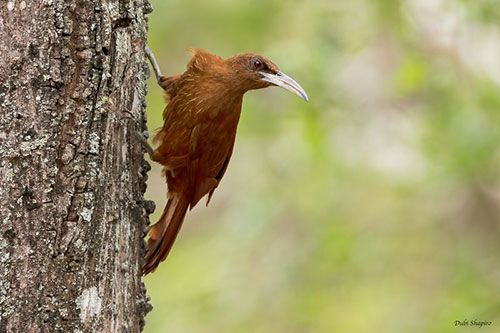
PROTECTION / THREATS / STATUS:
The Great Rufous Woodcreeper is affected by habitat loss caused by forest fragmentation. These birds need intact forest, and do not cross large unforested areas, involving a problem for their survival in such fragmented habitat.
The size of the population is unknown, but it is suspected to be declining.
The species is described as “uncommon” throughout the large range, but it is not globally threatened at the moment.
The Great Rufous Woodcreeper is currently evaluated as Least Concern.
Fr: Grand Grimpar
Ang: Great Rufous Woodcreeper
All: Rötelbaumsteiger
Esp: Trepatroncos Colorado - Trepador gigante
Ita: Rampicatore maggiore
Nd: Grote Muisspecht
Sd: större trädklättrare
Photographers:
John Anderson
John Anderson Photo Galleries
Jean Michel Fenerole
Photos d’Oiseaux du monde
William Price
PBase-tereksandpiper & Flickr William Price
Dubi Shapiro
Dubi Shapiro Photo Galleries
Text by Nicole Bouglouan
Sources:
HANDBOOK OF THE BIRDS OF THE WORLD Vol 8 By Josep del Hoyo-Andrew Elliott-David Christie - Lynx Edicions - ISBN: 8487334504
The Birds of South America: Vol. II, The Suboscine Passerines De Robert S. Ridgely, Guy Tudor, William L. Brown, World Wildlife Fund – Editor: University of Texas Press, 1989 – ISBN: 0292770634, 9780292770638 – 940 pages
Field Guide to the Songbirds of South America: The Passerines De Robert S. Ridgely, Guy Tudor – Editor: University of Texas Press, 2009 – ISBN: 0292717482, 9780292717480 – 750 pages
Animal Diversity Web (University of Michigan Museum of Zoology)
Wikipedia, the free encyclopaedia
Wikipedia, la enciclopedia libre
The bird and its nest, where everything starts… Page 3: Furnariidae (Ovenbirds)
Great Rufous Woodcreeper
Xiphocolaptes major
Passeriformes Order - Furnariidae Family
INTRODUCTION:
The Great Rufous Woodcreeper is found in South America, in Argentina, Bolivia, Brazil and Paraguay. Four subspecies share this large range.
It frequents a variety of forest habitats, gallery forest and Chaco woodland, scrubby forest and wooded savanna. The species occurs from below 1,500 to 1,800 metres of elevation.
It feeds mainly on insects, but it also takes arthropods and small vertebrates. It forages from the ground to the subcanopy, alone or in pairs.
This species nests in natural cavities to which it adds some vegetal lining. The female does most of the nesting duties. The reproductive behaviour is poorly known.
The Great Rufous Woodcreeper is described as uncommon over most of the range, but the species is not globally threatened at the moment.

DESCRIPTION OF THE BIRD:
Biometrics:
Length: 27-30 cm
Weight: M: 120-150 g – F: 120-162 g
The Great Rufous Woodcreeper is a large, almost uniformly rufous woodcreeper.
Some individuals may have an indistinct, pale shaft streaking on the breast, and some dusky bars on the belly.
On the upperwing, the flight-feathers are reddish-brown and the primaries have dark tips. The tail is more chestnut and the rectrices have stiff, spiny shafts that are claw-like, making them well-adapted for climbing trees.
On the cinnamon underparts, the throat is paler with some whitish and pale buff streaking. The undertail-coverts are cinnamon rufous.
The head is slightly more brownish or olive on the crown. The lores are blackish.
The long bill is heavy and slightly decurved. It is horn-coloured basally, and paler distally with blackish tip.
The eyes are dark brown, red-brown or crimson.
Legs and feet are dark greyish-olive, greenish or bluish-grey. The claws are well curved.
Male and female are similar.
The juvenile is usually paler than adults, with more brilliant coloration on the underparts. The breast is more obviously streaked.
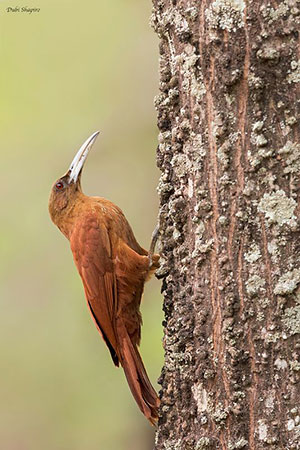
SUBSPECIES AND RANGE:
The Great Rufous Woodcreeper has four subspecies
X.m. major (described above) is found in W and C Paraguay and N Argentina (Jujuy, Salta and Formosa, S to Córdoba and NE Santa Fe).
X.m. remoratus occurs in SW Mato Grosso, Brazil.
This one has darker upperparts and less ferruginous underparts. The whitish area of the throat is more limited.
X.m. castaneus is found in NC and E Bolivia, SW Brazil (Mato Grosso do Sul) and NW Argentina (SE Jujuy and N Salta).
This race has darker appearance overall, and the head is more brownish. The upperparts are deeper chestnut, with narrower streaks on the breast and reduced barring on the belly.
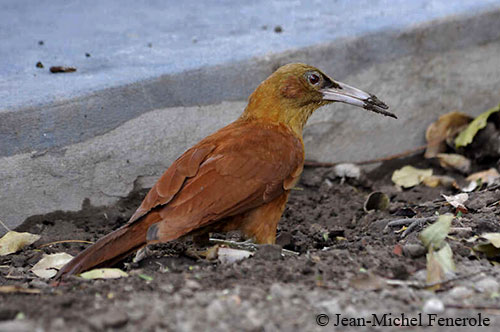
X.m. estebani occurs in Tucumán, in NW Argentina.
This one resembles nominate, but the plumage is much lighter overall.
HABITAT:
The Great Rufous Woodcreeper frequents several types of forested habitats such as dry woodland and semi-deciduous woodland, and also gallery forest and Chaco woodland (a semi-arid, hot lowland tropical dry broadleaf forest natural region of the Río de la Plata Basin).
But it also occurs in scrubby forest, wooded savanna and Cerrado (a vast ecoregion of tropical savanna in E Brazil).
The species prefers the forest interior, although it can be seen occasionally in savanna and edges.
It is present mostly below 1,500 metres, but also up to 1,800 metres of elevation.
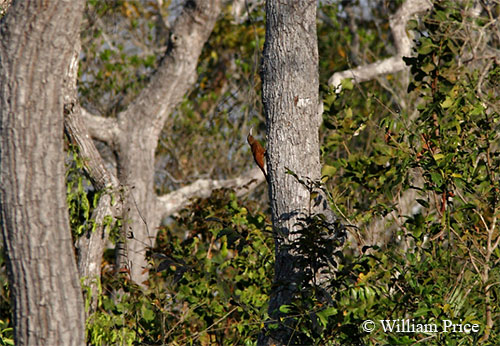
CALLS AND SONGS: SOUNDS BY XENO-CANTO
The loud, far-carrying song of the Great Rufous Woodcreeper is a slow, descending series of 12 disyllabic “hic-up” whistled notes interspersed with soft, whining or chattered notes. It is fairly long in duration. A soft, drawn out “eeehhh” usually begins the song which is described as “eeeh…hic-up-hic-up-hic-up”. It is usually heard at dawn and dusk.
The two-note call resembles the song but it is more emphatic and longer. It ends abruptly with a harsh, short note “eeehr-eek!”
BEHAVIOUR IN THE WILD:
The Great Rufous Woodcreeper is primarily insectivorous, but it may occasionally take small vertebrates such as amphibians and reptiles. It also consumes eggs and nestlings of songbird species.
The insect’s diet includes ants, grasshoppers and various types of beetle, bugs, earwigs and Lepidoptera larvae.
Some observations in the Brazilian Pantanal report predation on bats by the Great Rufous Woodcreeper. Both use shallow tree cavities for roosting, increasing encounters between the two species.
From an observation, the bird attacked the bat (Noctilio albiventris) on the ground by hammering the prey’s head with its strong bill. Then, it carried the prey in its beak to a tree trunk. There, it ingested thin strips of flesh, and tried to swallow the bat wholly, but without success. Then, the Great Rufous Woodcreeper flew away with the prey in the bill.
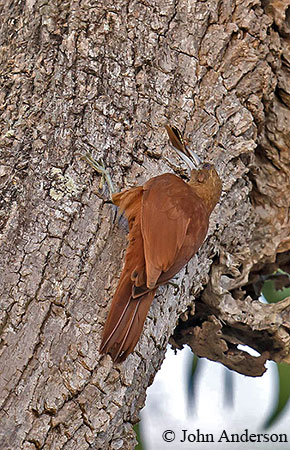
The Great Rufous Woodcreeper creeps among trunks and large branches, but it also forages on the ground where it hops clumsily. It gleans and probes, and searches among the leaf-litter or picks loudly on trunks.
It is usually observed alone or in pairs, and sometimes in groups of three individuals, probably family groups.
The breeding biology of woodcreepers is poorly known. The larger species appear to be socially monogamous with pair-bonds maintained throughout the year, and both adults share the nesting duties.
The Great Rufous Woodcreeper nests in natural cavities or abandoned woodpecker holes, usually within 5 metres above the ground. There is no evidence that they excavate their own nests, but they may enlarge the entrance. The young remain with their parents for long period, but no more a few months.
The Great Rufous Woodcreeper is resident.
The flight is undulating, like that of woodpeckers. But it does not cross large, unforested gaps.
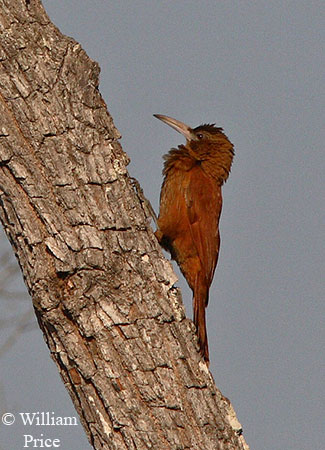
REPRODUCTION OF THIS SPECIES:
The breeding season of the Great Rufous Woodcreeper is not well defined, but includes October and November in Argentina, Paraguay and Bolivia.
This species nests in natural cavities in trees or holes in stumps, and also uses abandoned holes excavated by woodpecker. The nest is placed less than five metres above the ground. There is a long, narrow entrance, and the cup is lined with dry leaves, straw or wood chips. The depth of the cavity may reach 1-1,60 metres. The birds often enlarge the entrance with the bill, but they do not excavate the hole.
The female lays 2-3 white eggs. The duration of the incubation is unknown, but some information suggests duration of 14-16 days, and the young fledge 17 to 25 days after hatching.
The chicks are fed on insects, beetle larvae, grasshoppers and spiders. They usually remain with the adults for some months after fledging.
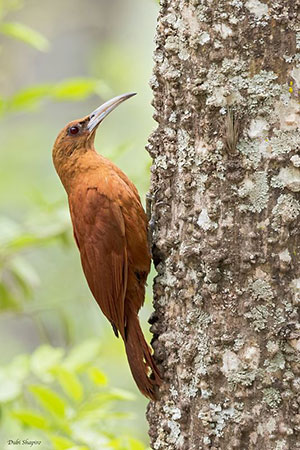
Here is the bird within
its forested habitat